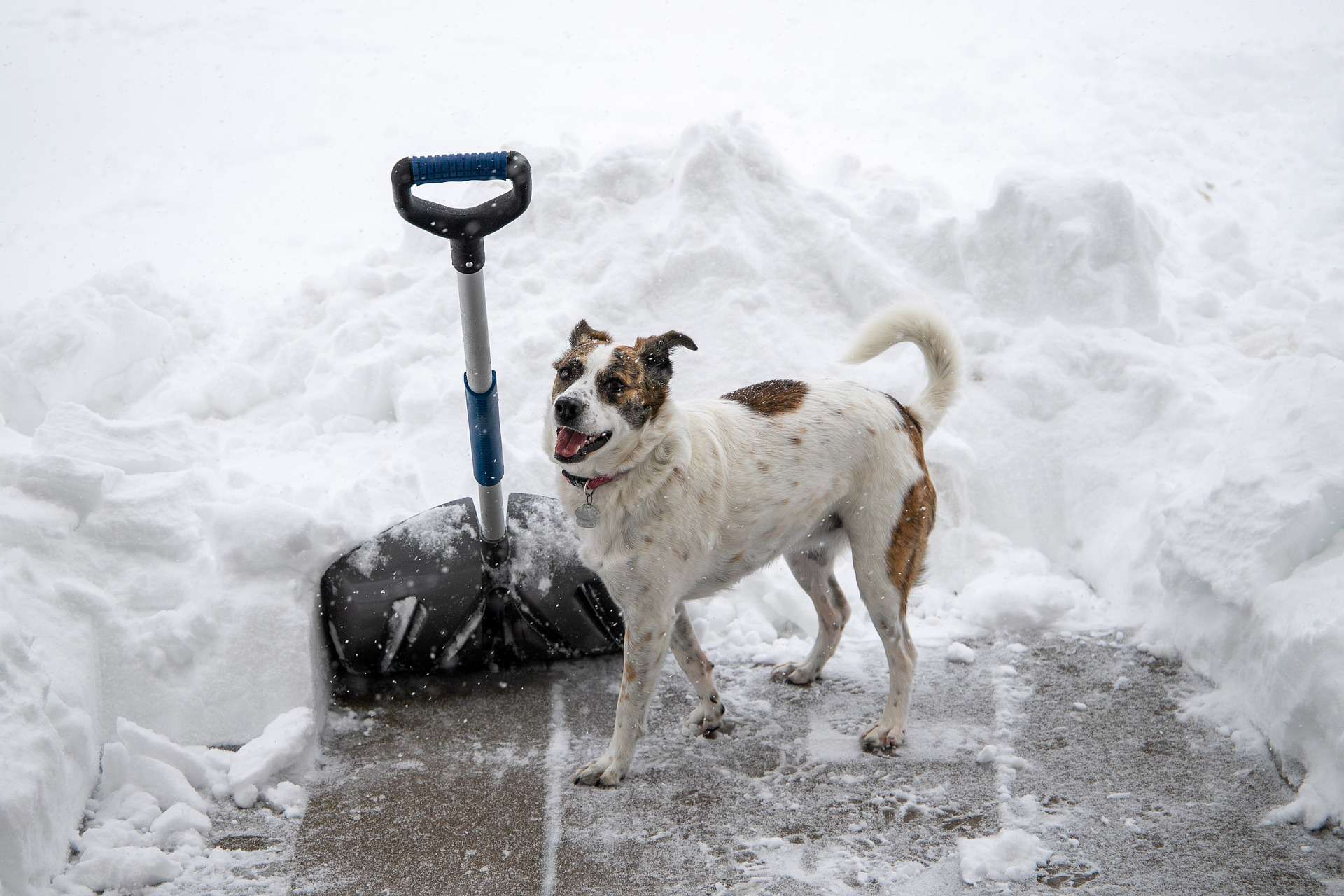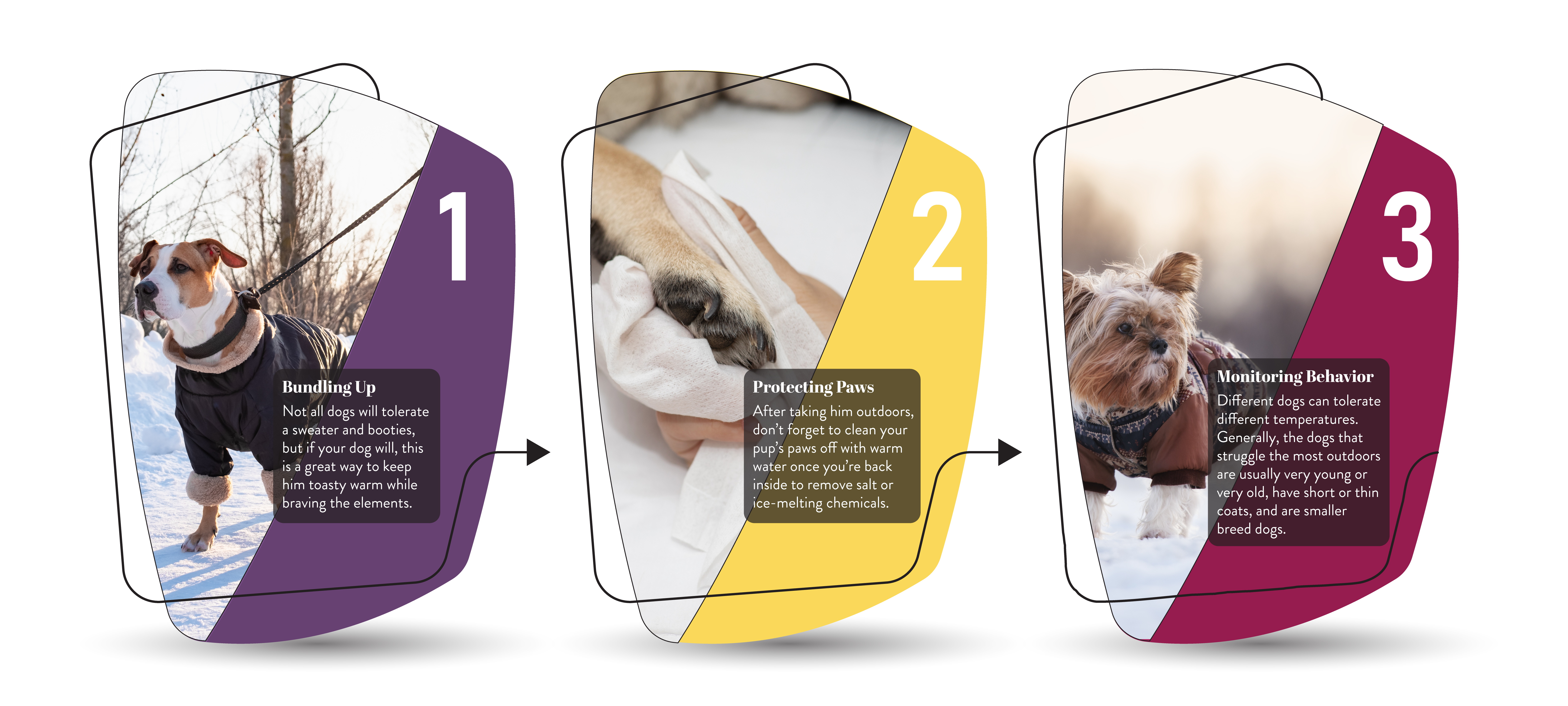How to Exercise Your Dog in the Winter
Posted by Lora Shaw on January 22, 2020

Exercising Your Dog in the Winter: What You Need to Know
- Protect your dog from the cold: To keep your dog warm during cold outdoor activities, utilize sweaters and booties. Be on the lookout for signs of frostbite, such as blisters or hard, waxy skin, especially on sensitive areas like paws, ears, and tail tips.
- Maintain paw health: If your dog resists wearing booties, clean their paws with warm water after outdoor exposure to remove any salt or ice-melting chemicals that can be harmful.
- Monitor your dog’s tolerance to cold: Pay attention to your dog’s behavior outdoors. Signs like whining, shivering, slowing down, lifting paws, or seeking warmth can indicate that it’s time to head back inside.
- Engage in indoor activities: Incorporate games such as tug-of-war, try treadmill sessions, or begin teaching them new tricks to keep your dog physically and mentally stimulated when outdoor exercise just isn’t feasible.
- Consider social opportunities: Arrange playdates with other dogs or enroll your pet in a doggie day care here at Pet Palace to provide exercise and social interaction during the colder months.
Winter weather can be downright uncomfortable, not just for you, but for your dog as well! However, even when it’s cold outside, your dog still needs their exercise. So, read on to learn how you can give Rover a workout while protecting them from snow and freezing temperatures.
How Can I Protect My Dog During the Winter?

During the winter, we recommend that you keep your dog safe outdoors by:
- Bundling up – Not all dogs will tolerate a sweater and booties, but if your dog will, this is a great way to keep him toasty warm while braving the elements. Since they have a built-in fur coat, we may think our pets are well-suited for the cold weather. But sensitive areas like the pads of their feet, ears, and the tips of their tail are as susceptible to frostbite as our own skin. Be watchful for the signs of frostbite, such as blisters and hard, waxy skin.
- Protecting paws – Got a stubborn, bootie-rejecting canine on your hands? After taking them outdoors, don’t forget to clean your pup’s paws off with warm water once you’re back inside to remove salt or ice-melting chemicals.
- Monitoring behavior – Different dogs can tolerate different temperatures. Generally speaking, the dogs that struggle the most outdoors are usually very young or very old, have short or thin coats, and are smaller breed dogs. Watch out for winter hazards as well. It is imperative that you keep any antifreeze solutions or other potentially poisonous substances well out of reach during the winter. And while we call it “salt,” road salt is actually a blend of chemicals that can prove toxic to our pets.
The best way to tell if your dog can handle the cold is to keep a close eye on them outside. If they begin to whine, shiver, slow down, seek out warmth, or hold up one paw at a time, call it quits and head indoors.
How Can I Exercise My Dog in the Winter?
To exercise your dog in the winter, we recommend any of the following activities:
- Walking – You can still walk your dog in the winter, but you’ll just need to make your walks shorter while making sure you monitor your dog for any signs of discomfort.
- Play tug-of-war – You don’t need to take your dog outdoors to get them active this winter. Instead, grab a rope and get a game of tug-of-war going. Your favorite furry friend will love competing to see who’s stronger.
- Use a treadmill – Got a treadmill collecting dust at home? Don’t let it go to waste when Fido can easily put it to good use! Just make sure to keep the treadmill at a comfortable pace for your dog and supervise any treadmill time.
- Schedule a play date – Does Spot have a BFF? If so, why not schedule a date with your dog’s bestie so they have someone to run around with? Doing so will give your dog the opportunity to frolic and have fun, while giving you the chance to catch up with one of your favorite pet parents. Talk about win-win!
- Doggie day care – Your dog doesn’t want to be cooped up all winter long! Fortunately, they don’t have to be. With doggie day care, they can catch up on their exercise while making new canine friends. And as a bonus, they’ll be spoiled rotten by our dog-loving staff once they arrive.
- Take them on a field trip to an indoor dog agility training center – If you are lucky enough to have an indoor training center for dogs near you, definitely take advantage of it. This is the next best thing to being outside. With ramps, tunnels, and other obstacles and courses to run through, your dog will have no shortage of play time and healthy exercise.
- Use this time to teach your pup a new trick – Healthy exercise does not mean intense running for 30 minutes. Simple movements count as healthy exercise too! The winter season is a great time to teach your dog how to sit, stay, roll over, shake, and speak! One way to incorporate training with exercise is to have your pup play a doggie version of hide-and-seek. Create an obstacle course and hide a treat at the end. Your dog will have to seek out the treat by going through the course.
- Purchase a food or treat dispensing toy – These are great for the days when you don’t have the time to keep your dog busy. They can entertain themselves by playing with the toy to get their reward. These are great too because you also get to control how many treats you put inside the toy.
The Importance of Keeping Your Pup Active in the Winter
It’s natural to want to snuggle up indoors during the winter months to keep warm and comfortable until the spring. While both you and your pup may enjoy the coziness of the fireplace and a warm blanket, keeping your dog active during the winter months is extremely important.
Not only will an active effort to stay up and moving with your pup reduce the feeling of boredom, but it is also a key component of a dog’s well-being and overall health. Limiting your dog’s exercise can significantly decrease the quality of their life. It is important to avoid this by making sure they are active most, if not all, days of the week. Big or small, dogs benefit from daily exercise. Depending on the age and breed of your pup, it is usually best to get at least 30 minutes in each day.
Some of the additional reasons to keep your dog active in the winter include:
- Mental stimulation – Similar to humans, the cold winter months can have adverse effects on dogs and cause potentially destructive behaviors. With limited outdoor activities available, it is important to introduce things such as puzzle toys and interactive games to challenge your dog and lessen boredom. Check out some winter toys we recommend to keep your pup active.
- Maintaining physical health – Cardiovascular fitness is crucial for a dog’s well-being and health. With that being said, limited outdoor activity does not mean your pup shouldn’t be moving around. Finding opportunities to take brisk outdoor walks or indoor play sessions will help maintain the physical health of your pup. Benefits of year-round physical activity include building and toning muscle, keeping your dog’s metabolic system functioning properly, maintaining the function of their bones and joints, and more.
- Socialization opportunities – Just like us, dogs need to feel stimulated and interact outside of their own home. Look for opportunities to join indoor dog playgroups, attend dog-friendly events, and organize playdates with fellow pups. Socialization can help dogs avoid the winter blues and lessen the feelings of isolation.
- Weight management – The nature of the holidays typically brings an increased number of tasty treats and table scraps which can contribute to excessive weight gain. Maintaining an active lifestyle using some of the tips provided above will help regulate your pup’s weight and promote an active lifestyle.
FAQs on Keeping Your Dog Active in the Winter
What are some indoor activities I can do with my dog?
There are many ways to get creative and make some fun for you and your pup to promote an active lifestyle. Some of the activities we recommend are playing fetch, using a laser pointer, engaging in some hide and seek, and getting a puzzle feeder.
All of these are great ways to promote brain stimulation and activity in between cozying up on the couch.
Is it safe to take my dog for a walk in the cold?
Generally, it is safe to walk your dog in the cold weather, but it is important to consider the temperature and your dog’s breed. Gear such as doggy sweaters or boots can be great tools to keep your pup comfortable.
You’ll also want to adjust the duration of the walks depending on the temperature and your dog’s tolerance to the cold.
Are there specific winter sports suitable for dogs?
There are various winter sports for dogs to enjoy such as hiking, snowshoeing, and even skijoring. However, we would recommend consulting with your local vet to ensure your dog is the right age and breed, and in good enough health to participate in these activities.
Does my dog’s age have an influence on how much exercise they need?
In short, yes. Typically, older or less active dogs tend to be more sensitive to the cold so it is recommended to partake in shorter and gentler activities when it is cold outside. As noted above, you’ll also want to provide additional warmth with sweaters, boots, or scarves to keep your pup comfortable during these activities.
If you want to learn more about how to care for your pup in the winter months, check out our blog post on cold-weather pet activities.

Categories: Dog Daycare, Dogs, Pet Safety, Tips for Your Pets
Archives
Recent Articles
Categories
Monthly Archive
- August 2025
- July 2025
- June 2025
- May 2025
- April 2025
- March 2025
- February 2025
- January 2025
- December 2024
- November 2024
- October 2024
- September 2024
- August 2024
- July 2024
- June 2024
- May 2024
- April 2024
- March 2024
- February 2024
- January 2024
- December 2023
- November 2023
- October 2023
- August 2023
- July 2023
- June 2023
- May 2023
- April 2023
- March 2023
- February 2023
- January 2023
- December 2022
- November 2022
- October 2022
- August 2022
- July 2022
- June 2022
- April 2022
- March 2022
- February 2022
- November 2021
- October 2021
- November 2020
- September 2020
- July 2020
- March 2020
- January 2020
- November 2019
- September 2019
- July 2019
- March 2019
- January 2019
- December 2018
- November 2018
- October 2018
- August 2018
- July 2018
- June 2018
- May 2018
- April 2018
- March 2018
- February 2018
- January 2018
- December 2017
- November 2017
- October 2017
- September 2017
- August 2017
- July 2017
- June 2017
- May 2017
- April 2017
- March 2017
- February 2017
- January 2017
- December 2016
- November 2016
- September 2016
- August 2016
- July 2016
- June 2016
- May 2016
- April 2016
- March 2016
- February 2016
- December 2015
- November 2015
- October 2015
- September 2015
- August 2015
- July 2015
- May 2015
- March 2015
- February 2015
- January 2015
- December 2014
- November 2014
- September 2014
- August 2014
- July 2014
- June 2014
- May 2014
- March 2014
- February 2014
- January 2014
- December 2013
- November 2013
- October 2013
- September 2013
- August 2013
- June 2013
- May 2013
- March 2013
